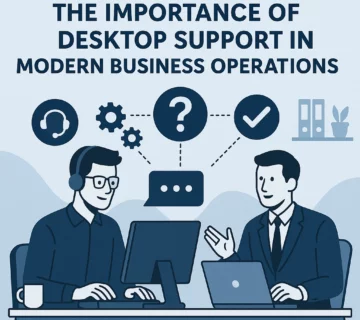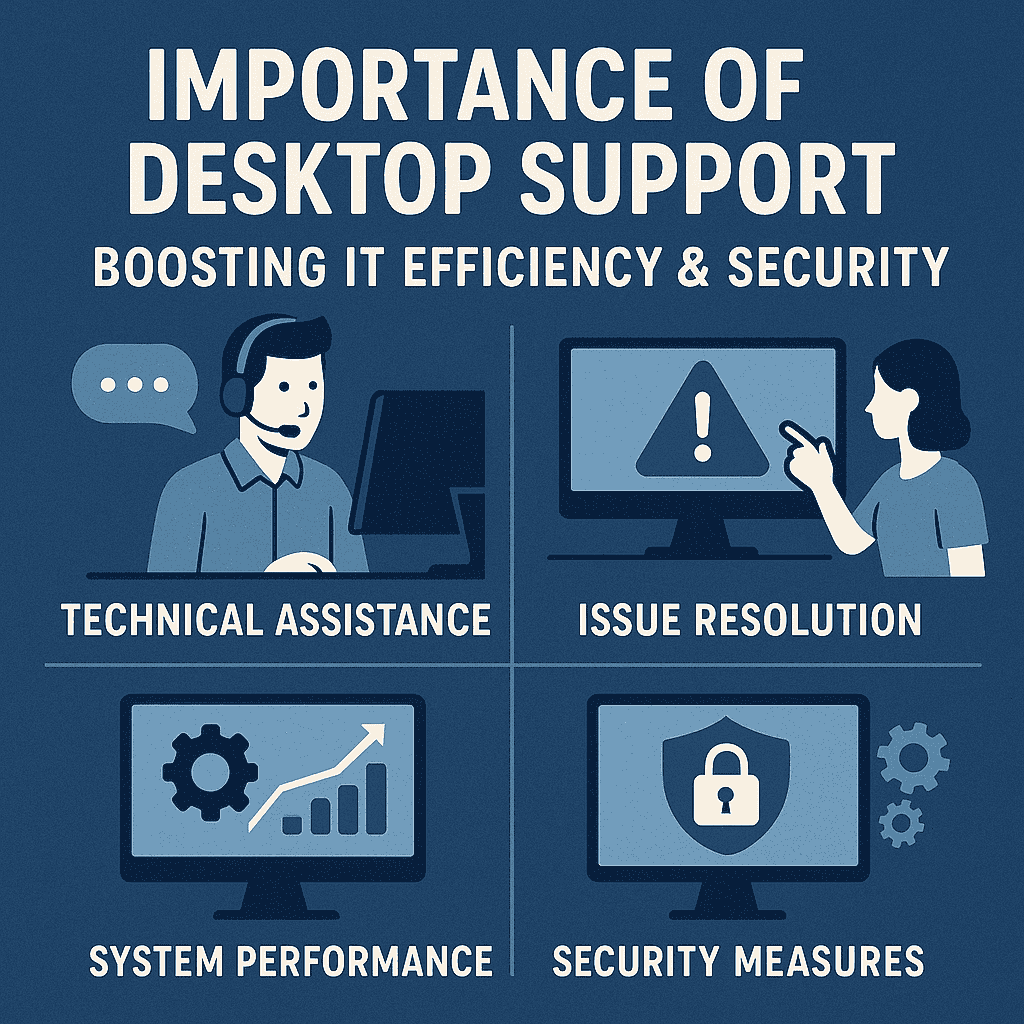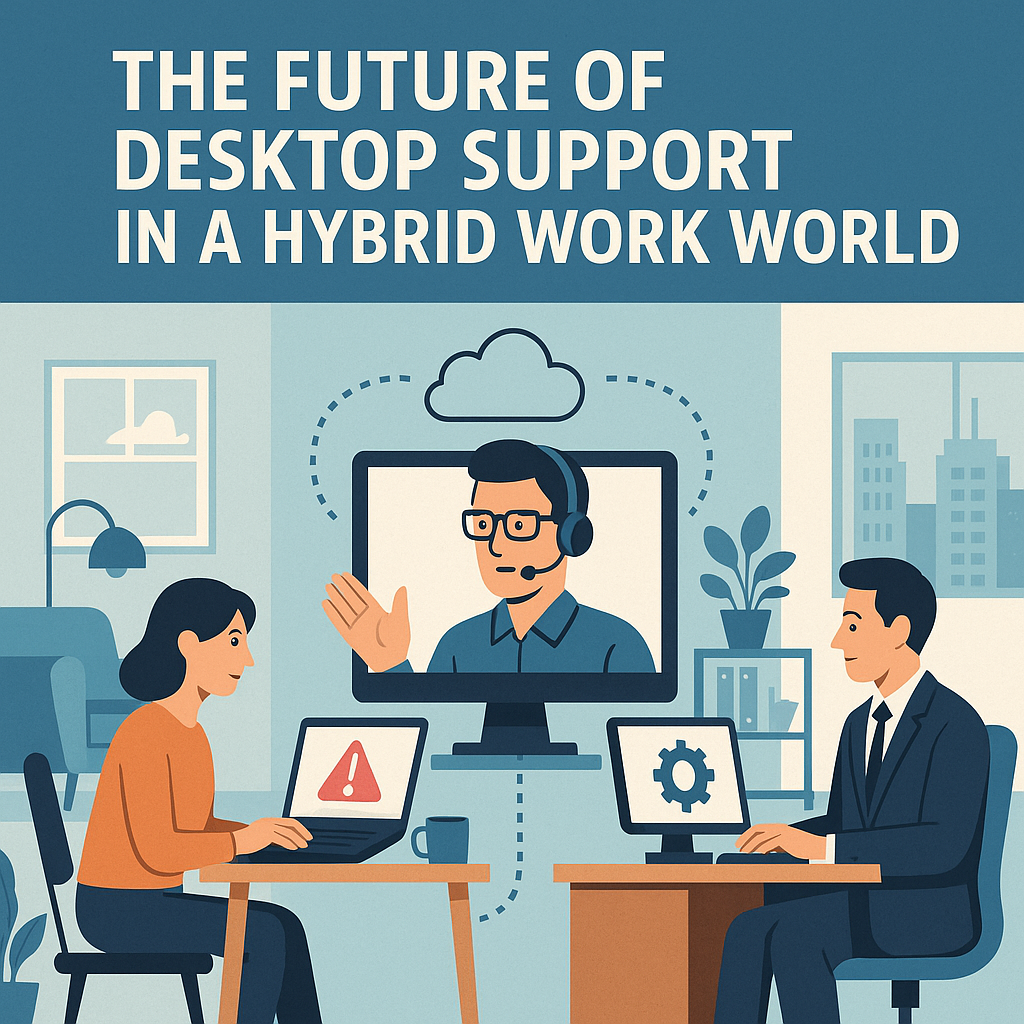Top Desktop Support Practices Every Business Should Know
Introduction to Desktop Support
What Is Desktop Support?
Desktop support services involve assisting end users with technical problems related to hardware, software, networking, and peripherals. These services are typically delivered by a trained desktop support technician or a desktop support specialist within an organization’s IT team.
Why Desktop Support Matters in Business
In today’s digital workplace, virtually every employee relies on a functioning computer. IT desktop support ensures business continuity, boosts employee productivity, and reduces downtime due to technical issues.
Setting Up an Efficient Desktop Support System
Centralized Help Desk Infrastructure
A central help desk model organizes support requests, assigns tasks, tracks progress, and allows better analysis of IT challenges across departments.
Creating Clear Support Protocols
Defined processes for ticket prioritization, escalation, and resolution empower both users and the desktop support services team to operate more efficiently.
Best Practices for Desktop Support Teams
Fast Response Time
Time is money—especially when employees are stuck due to IT issues. Ensuring quick responses is vital to maintaining workflow.
Clear Communication with End Users
Technicians should communicate using simple language, keeping the user informed and confident in the resolution process.
Documenting Every Issue
Documentation supports issue tracking, root cause analysis, and knowledge sharing within the team.
Proactive Maintenance and Monitoring
Scheduled System Updates
Regular updates prevent vulnerabilities and compatibility issues.
Remote Monitoring Tools
Tools that alert the desktop support technician to hardware issues before they become critical allow for timely intervention.
Early Detection of Failures
Monitoring hard drives, CPUs, and memory usage helps in identifying failing components before they cause outages.
Security-Focused Desktop Support
Role-Based Access Control
Access control minimizes internal risks by limiting privileges based on job roles.
Antivirus and Endpoint Protection
All devices must have up-to-date antivirus software, firewall protection, and endpoint monitoring tools.
Educating Users on Cyber Hygiene
End users are often the weakest link in cybersecurity. Provide ongoing training to reduce risks like phishing or social engineering.
Standardization and Automation
Imaging and Cloning Systems
Using pre-configured images saves setup time, ensures consistency, and reduces errors in configuring new devices.
Automation Through Scripting
Routine tasks like cleanup, software installation, and password resets can be handled by PowerShell or Bash scripts.
Training and Upskilling Support Staff
Technical Certifications
Certifications such as desktop support technician certification, CompTIA A+, and Microsoft’s Modern Desktop Administrator validate expertise and improve service quality.
Soft Skills Development
Empathy, patience, and clear communication enhance the user experience and team efficiency.
Fostering a Culture of Learning
Encourage peer learning, webinars, and online training to keep the team current with new tools and trends.
End User Education and Empowerment
Onboarding IT Orientation
Educating new hires about tools, systems, and support resources improves independence and reduces help desk requests.
Self-Service Knowledge Bases
Help users resolve basic issues through FAQ sections, video tutorials, and chatbots.
Phishing and Email Threat Awareness
Simulated phishing tests help train employees to recognize scams and report suspicious activity.
Using Key Metrics in Desktop Support
First Call Resolution (FCR)
A high FCR rate indicates efficient support and problem-solving.
Mean Time to Resolve (MTTR)
Monitoring MTTR helps identify bottlenecks in the resolution process.
Customer Satisfaction Score (CSAT)
Gathering user feedback ensures continuous improvement and helps track technician performance.
Cloud-Based Tools for Desktop Support
Ticketing and Help Desk Software
Platforms like Freshdesk, Spiceworks, or Zendesk help manage ticket flow and automate updates.
Remote Access Utilities
Tools like AnyDesk, TeamViewer, and LogMeIn allow desktop support technicians to resolve issues without being physically present.
Collaboration Tools
Integration with Teams, Slack, or Zoom streamlines internal communication and user guidance.
Supporting BYOD and Mobile Devices
Cross-Platform Compatibility
Your support team should be equipped to manage devices running on Windows, macOS, Linux, Android, and iOS.
Mobile Device Management (MDM)
An MDM solution helps enforce encryption, control access, and enable remote wipes in case of loss or theft.
Common Mistakes to Avoid in Desktop Support
Overcomplicating Workflows
Simple workflows make support easier to navigate for both technicians and end users.
Neglecting Issue Documentation
Without clear records, recurring problems waste time and lower morale.
Ignoring Feedback
User complaints or suggestions should be tracked, analyzed, and implemented where applicable.
Adapting Desktop Support to Hybrid Work Environments
Remote Work Infrastructure
Ensure all users can securely access systems remotely using VPNs, secure cloud services, and reliable support tools.
Virtual Collaboration Support
Keep remote teams engaged and connected using real-time communication and troubleshooting tools.
Hardware Allocation and Management
Ship pre-configured laptops and provide remote support to reduce setup issues for remote workers.
Outsourcing vs. In-House Desktop Support
Benefits of In-House Teams
- Better familiarity with internal systems
- Cultural alignment
- Quicker on-site support
Advantages of Outsourcing
- Reduced costs
- 24/7 availability
- Access to a broader range of expertise
Choosing What’s Right for You
Small businesses often benefit from outsourced desktop support services, while larger firms may prefer dedicated internal teams for greater control.
Leveraging AI and Automation in IT Desktop Support
AI-Powered Chatbots
Chatbots handle FAQs, reset passwords, and collect user data before escalating to a desktop support technician.
Predictive Maintenance
AI tools analyze system behavior to predict and prevent failures before they affect users.
Workflow Automation
Automate software installations, updates, and patch rollouts to improve efficiency.
Cross-Functional Collaboration in Desktop Support
HR and IT
Coordinate onboarding/offboarding processes to streamline account creation and access control.
Security and Compliance
Ensure endpoint security and access logging aligns with industry regulations like HIPAA or PCI-DSS.
Sustainable IT Practices in Desktop Support
Green Hardware Management
Choose energy-efficient devices and configure them for low-power operation.
Recycling and Reuse
Participate in hardware recycling programs and consider refurbishing older devices for non-critical tasks.
Career Path for Desktop Support Professionals
From Technician to Engineer
A desktop support specialist can grow into senior roles like Systems Engineer, IT Administrator, or Network Engineer.
Mentoring Programs
Pair junior technicians with experienced mentors to boost growth and morale.
Advanced Tools Every Technician Should Know
| Tool Type | Examples | Purpose |
|---|---|---|
| Ticketing | Freshservice, Jira | Manage and prioritize tickets |
| Remote Access | TeamViewer, AnyDesk | Support remote users |
| Imaging | Clonezilla, Acronis | Rapid device deployment |
| Scripting | PowerShell, Python | Automate routine tasks |
| Monitoring | NinjaOne, SolarWinds | Track device health |
Frequently Asked Questions
What’s the role of a desktop support technician?
They assist with system setups, troubleshoot hardware/software issues, maintain user devices, and implement updates.
Is a desktop support technician certification necessary?
Yes. Certifications like CompTIA A+ or Microsoft Modern Desktop Administrator validate skills and increase job opportunities.
What distinguishes desktop support services from general IT support?
Desktop support is focused on end-user systems, while IT support may also include servers, networking, and infrastructure.
Can desktop support be automated?
Yes—routine tasks like software updates and diagnostics can be automated, but human intervention is still required for complex problems.
Should startups outsource their desktop support?
Outsourcing is often cost-effective for startups, especially when internal resources are limited.
Conclusion
Effective desktop support is more than reactive troubleshooting—it’s a strategic function that improves productivity, safeguards systems, and empowers users. By following the top desktop support practices every business should know, organizations can minimize downtime, enhance security, and support long-term growth.
From leveraging desktop support technician certification to automating routine tasks and personalizing user interactions, these best practices help modern businesses stay agile and efficient.





No comment